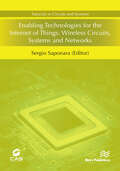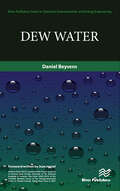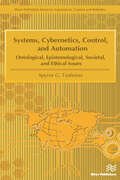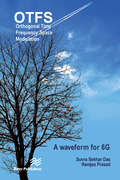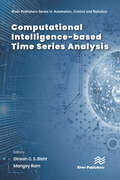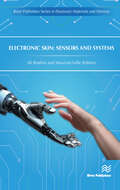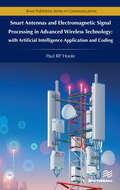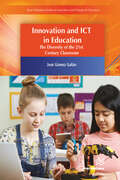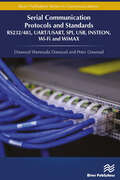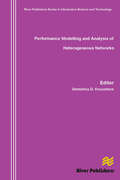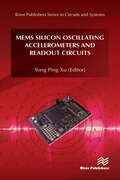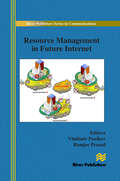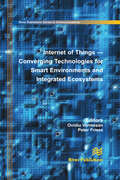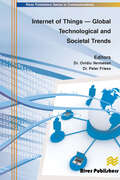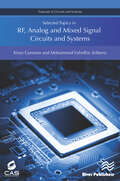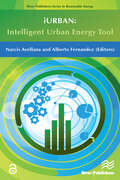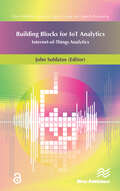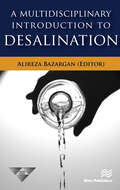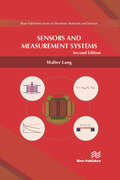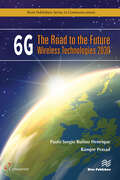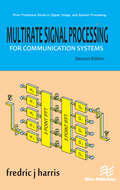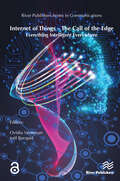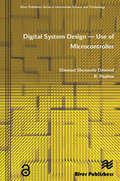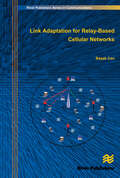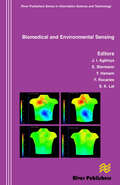- Table View
- List View
Enabling Technologies for the Internet of Things: Wireless Circuits, Systems and Networks
by Sergio SaponaraEnabling Technologies for the Internet of Things: Wireless Circuits, Systems and Networks collects slides and notes from the lectures given in the 2017 Seasonal School Enabling Technologies for the Internet-of-Things, supported by IEEE CAS Society and by INTEL funding, and organized by Prof. Sergio Saponara, and Prof. Giuliano Manara. The book discusses new trends in Internet-of-Things (IoT) technologies, considering technological and training aspects, with special focus on electronic and electromagnetic circuits and systems. IoT involves research and design activities both in analog and in digital circuit/signal domains, including focus on sensors interfacing and conditioning, energy harvesting, low-power signal processing, wireless connectivity and networking, functional safety (FuSa). FuSa is one of the emerging key issues in IoT applications in safety critical domain like industry 4.0, autonomous and connected vehicles and e-health. Our world is becoming more and more interconnected. Currently it is estimated that two hundred billion smart objects will be part of the IoT by 2020. This new scenario will pave the way to innovative business models and will bring new experiences in everyday life. The challenge is offering products, services and comprehensive solutions for the IoT, from technology to intelligent and connected objects and devices to connectivity and data centers, enhancing smart home, smart factory, autonomous driving cars and much more, while at the same time ensuring the highest safety standards. In safety-critical contexts, where a fault could jeopardize the human life, safety becomes a key aspect.
Dew Water (River Publishers Series In Chemical, Environmental, And Energy Engineering Ser.)
by Daniel BeysensThe world’s ever-increasing need for fresh water has led to the use of non-conventional sources such as rain and fog water collection. Although rain water collection is relatively simple, the supply is often erratic. Passive fog water collection has been used in several parts of the world but is only relevant to certain geographical locations. Dew occurrence, however, is far more widespread, can form in most climates and geographic settings, show high frequency and prevalence throughout the year. During the past 20 years, dew collection has therefore been investigated as a serious supplemental source of fresh water. Dew Water offers a thorough review of dew, its formation characteristics and potential for dew collection, for audiences that include policy-makers, non-governmental organizations involved in development aid and sustainable development, engineers, urban planners, researchers and students.After providing a background on atmospheric water, humid air, and sky and materials emissivity, the book deals with dew formation and its estimation with a focus on the use of meteorological data. Dew measurement techniques are reviewed and discussed as well as dew collection by passive means. Computational fluid dynamics technique is described for better design of dew collectors. Dew quality (chemistry, biology) is assessed in view of potable water quality. Costs and economic aspects are also considered.
Systems, Cybernetics, Control, and Automation
by Spyros G. TzafestasSystems, cybernetics, control, and automation (SCCA)are four interrelated and overlapping scientific and technological fields that have contributed substantially to the development, growth, and progress of human society. A large number of models, methods, and tools were developed that assure high efficiency of SCCA applied to practical situations. The real-life applications of SCCA encompass a wide range of man-made or biological systems, including transportations, power generation, chemical industry, robotics, manufacturing, cybernetics organisms (cyborgs), aviation, economic systems, enterprise, systems, medical/health systems, environmental applications, and so on. The SCCA fields exhibit strong influences on society and rise, during their use and application, many ethical concerns and dilemmas. This book provides a consolidated and concise overview of SCCA, in a single volume for the first time, focusing on ontological, epistemological, social impact, ethical, and general philosophical issues. It is appropriate for use in engineering courses as a convenient tutorial source providing fundamental conceptual and educational material on these issues, or for independent reading by students and scientists.Included in the book is:• Background material on philosophy and systems theory• Major ontological, epistemological, societal and ethical/philosophical aspects of the four fields that are considered in the book• Over 400 references and a list of 130 additional books in the relevant fields • Over 100 colored photos and 70 line figures that illustrate the text
Orthogonal Time Frequency Space Modulation: OTFS a waveform for 6G
by Suvra Sekhar Das Ramjee PrasadOver the last few decades wireless communications, especially Mobile Communication Technology, has evolved by leaps and bounds. The mobile communication industry has named the different major changes as generations namely 1G, 2G,..5G. We are presently looking at deployment of 5G technologies. The work for 6G has already started.This book is focused on the waveform design of 6G. It presents a discourse on a potential waveform for 6G namely Orthogonal Time Frequency Space (OTFS) modulation. OTFS has a distinct feature when compared to earlier generation waveforms such that information bearing signal is placed in the delay Doppler domain as opposed to the usual placement of such signals in the time-frequency domain. This unique feature of OTFS enables it to overcome several disadvantages of a very popular and highly successful waveform namely Orthogonal Frequency Division Multiplexing (OFDM). OTFS is known to be more resilient to frequency offset and Doppler which is one of the key drawbacks of OFDM. With this feature, OTFS, can support higher mobility as well as higher frequency bands of operation which is also one of the key requirements of the next generation wireless communication technologies. The implementation complexity of OTFS remains comparable to that of OFDM. It is found that OTFS provides significant SNR advantage, higher resilience, lower PAPR, lower out of band signal leakage and higher multi-user spectral efficiency than that of OFDM. This book addresses• Fundamental signal model of OTFS. • Receiver design for OTFS• Channel estimation in OTFS• Multiple Access through non-orthogonal multiple access (NOMA-OTFS) The contents of the books are primarily outcome of the research work done at the G. S. Sanyal School of Telecommunications, Indian Institute of Technology Kharagpur, Kharagpur, India.Orthogonal Time Frequency Space Modulation : A waveform for 6G is ideal for personnel the wireless communication industry as well as academic staff and master/research students in electrical engineering with a specialization in wireless communications.
Computational Intelligence-based Time Series Analysis
by Dinesh C. S. Bisht Mangey RamThe sequential analysis of data and information gathered from past to present is called time series analysis. Time series data are of high dimension, large size and updated continuously. A time series depends on various factors like trend, seasonality, cycle and irregular data set, and is basically a series of data points well-organized in time. Time series forecasting is a significant area of machine learning. There are various prediction problems that are time-dependent and these problems can be handled through time series analysis. Computational intelligence (CI) is a developing computing approach for the forthcoming several years. CI gives the litheness to model the problem according to given requirements. It helps to find swift solutions to the problems arising in numerous disciplines. These methods mimic human behavior. The main objective of CI is to develop intelligent machines to provide solutions to real world problems, which are not modelled or are too difficult to model mathematically. This book aims to cover the recent advances in time series and applications of CI for time series analysis.
Electronic Skin: Sensors and Systems
by Ali Ibrahim Maurizio ValleConsiderable amount of effort has been devoted, over the recent years, towards the development of electronic skin (e-skin) for many application domains such as prosthetics, robotics, and industrial automation. Electronic Skin: Sensors and Systems focuses on the main components constituting the e-skin system. The e-skin system is based on: i) sensing materials composing the tactile sensor array, ii) the front end electronics for data acquisition and signal conditioning, iii) the embedded processing unit performing tactile data decoding, and iv) the communication interface in charge of transmitting the sensors data for further computing. Technical topics discussed in the book include: • Tactile sensing material; • Electronic Skin systems;• Embedded computing and tactile data decoding; • Communication systems for tactile data transmission; • Relevant applications of e-skin system; The book takes into account not only sensing materials but it also provides a thorough assessment of the current state of the art at system level. The book addresses embedded electronics and tactile data processing and decoding, techniques for low power embedded computing, and the communication interface. Electronic Skin: Sensors and Systems is ideal for researchers, Ph.D. students, academic staff and Masters/research students in sensors/sensing systems, embedded systems, data processing and decoding, and communication systems.
Smart Antennas and Electromagnetic Signal Processing in Advanced Wireless Technology
by Paul R.P. HooleThe book addresses the current demand for a scientific approach to advanced wireless technology and its future developments. It gives a clear presentation of both antennas and adaptive signal processing which is what makes antennas powerful, maneuverable and necessary for advanced wireless technology. The book presents electromagnetic signal processing techniques that both control the antenna beam and track the moving station, which is required for effective, fast, dynamic beamforming.The first part of the book presents a comprehensive description and analysis of basic antenna theory, starting from short dipole antennas to array antennas. This section also includes important concepts related to antenna parameters, electromagnetic wave propagation, the Friis equation, the radar equation and wave reflection and transmission through media.The second part of the book focuses on smart antennas, commencing from a look at the traditional approach to beamforming before getting into the details of smart antennas. Complete derivation and description of the techniques for electromagnetic field signal processing techniques for adaptive beamforming are also presented. Artificial Intelligence (AI) driven beamforming is presented using computationally fast and low-memory demanding technique for AI beamforming is presented with the different excitation functions available. A novel method for fast, low memory and accurate, maneuverable single beam generation is presented, as well as other methods for beamforming with fewer elements along with a simple method for tracking the mobile antenna and station. In this section, for completeness, the use of antenna signal processing for synthetic aperture techniques for imaging is also presented, specifically the Inverse Synthetic Aperture Imaging technique.The third part of the book presents technological aspects of advanced wireless technology, including the 5G wireless system and the various devices needed to construct it. While the books’ main emphasis is theoretical understanding and design, it includes applications, and legal matters are also presented.
Innovation and ICT in Education: The Diversity of the 21st Century Classroom
by José Gómez GalánThe adequate integration of information and communication technologies (ICT) in educational and training processes is one of the biggest current challenges in education. The classroom of the present is very different from just a few decades ago, new technological tools are completely transforming its characteristics and activities. This internationally authored book offers a timely, effective and practical vision of this new educational scenario.The book takes a multidisciplinary approach in looking at the problems and possible solutions that are faced by the educational professional of the 21st century when, by necessity or obligation, they face the use of ICT in their daily tasks. Divided into two parts, one theoretical and another practical, this book offers the highlights of the most important lines of research that are being developed today in educational technology, and importantly presents the innovations which have had the most impact over recent years. From the profound transformations in the physical classroom to everything that involves new virtual scenarios, where online teaching requires innovative strategies and training processes, this book describes the diverse scenarios that ICT has generated and will continue to generate in the field of education. It presents a new and a very different type of education that can be adapted to the needs of the citizen of the digital society.
Serial Communication Protocols and Standards: Rs232/485, Uart/usart, Spi, Usb, Insteon, Wi-fi And Wimax (River Publishers Series In Communications Ser.)
by Dawoud Shenouda Dawoud Peter DawoudData communication standards are comprised of two components: The “protocol” and “Signal/data/port specifications for the devices involved”. The protocol describes the format of the message and the meaning of each part of the message. To connect any device to the bus, an external device must be used as an interface which will put the message in a form which fulfills all the electrical specifications of the port. These specifications are called the “Standard”. The most famous such serial communication standard is the RS-232.In IT technology, Communication can be serial or parallel. Serial communication is used for transmitting data over long distances. It is much cheaper to run the single core cable needed for serial communication over a long distance than the multicore cables that would be needed for parallel communication. It is the same in wireless communication: Serial communication needs one channel while parallel needs multichannel. Serial Communication can also be classified in many other ways, for example synchronous and asynchronous; it can also be classified as simplex, duplex and half duplex.Because of the wide spread of serial communication from home automation to sensor and controller networks, there is a need for a very large number of serial communication standards and protocols. These have been developed over recent decades and range from the simple to the highly complicated. This large number of protocols was necessary to guarantee the optimum performance for the targeted applications. It is important for communication engineers to have enough knowledge to match the right protocol and standard with the right application. The main aim of this book is to provide the reader with that knowledgeThe book also provides the reader with detailed information about:- Serial Communication- Universal Asynchronous Receiver Transmitter (UART)- Universal Synchronous/Asynchronous Receiver Transmitter (USART - Serial Peripheral Interface (SPI) - eSPI- Universal Serial Bus (USB)- Wi-Fi- WiMax- InsteonThe details of each technology including specification, operation, security related matters, and many other topics are covered.The book allocates three chapters to the main communication standards. These chapters cover everything related to the most famous standard RS-232 and all its variants. Other protocols such as: I2C, CAN, ZigBee, Z-Wave, Bluetooth, and others, are the subject of the authors separate book “Microcontroller and Smart Home Networks”.
Performance Modelling and Analysis of Heterogeneous Networks
by Demetres D. KouvatsosOver the recent years, a considerable amount of effort has been devoted, both in industry and academia, towards the performance modelling, evaluation and prediction of convergent multi-service heterogeneous networks, such as wireless and optical networks, towards the design and dimensioning of the next and future generation Internets.This book follows Heterogeneous Networks: Traffic Engineering, Performance Evaluation Studies and Tools and presents recent advances in networks of diverse technology reflecting the state-of-the-art technology and research achievements in performance modelling, analysis and applications worldwide.Technical topics discussed in the book include:• Multiservice Switching Networks;• Multiservice Switching Networks;• Wireless Ad Hoc Networks;• Wireless Sensor Networks;• Wireless Cellular Networks;• Optical Networks;Heterogeneous Networks:- Performance Modelling and Analysis contains recently extended research papers, which have their roots in the series of the HET-NETs International Working Conferences focusing on the 'Performance Modelling and Evaluation of Heterogeneous Networks' under the auspices of the EU Networks of Excellence Euro-NGI and Euro-FGI.Heterogeneous Networks: Performance Modelling and Analysis is ideal for personnel in computer/communication industries as well as academic staff and master/research students in computer science, operational research, electrical engineering and telecommunication systems and the Internet.KeywordsHeterogeneous networks, performance modelling and analysis, wired networks, wireless networks: ad hoc, sensor and cellular, optical networks, next and future generation Internets.
MEMS Silicon Oscillating Accelerometers and Readout Circuits (River Publishers Series In Circuits And Systems Ser.)
by Yong Ping XuMost MEMS accelerometers on the market today are capacitive accelerometers that are based on the displacement sensing mechanism. This book is intended to cover recent developments of MEMS silicon oscillating accelerometers (SOA), also referred to as MEMS resonant accelerometer. As contrast to the capacitive accelerometer, the MEMS SOA is based on the force sensing mechanism, where the input acceleration is converted to a frequency output. MEMS Silicon Oscillating Accelerometers and Readout Circuits consists of six chapters and covers both MEMS sensor and readout circuit, and provides an in-depth coverage on the design and modelling of the MEMS SOA with several recently reported prototypes. The book is not only useful to researchers and engineers who are familiar with the topic, but also appeals to those who have general interests in MEMS inertial sensors. The book includes extensive references that provide further information on this topic.
Resource Management in Future Internet
by Vladimir Poulkov Ramjee PrasadFuture Internet and Internet of Things set out a new vision for connectivity, real-time applications and services. Data procured from the use of a large number of heterogeneous physical and virtual devices must be real-time processed and analyzed for the goal of effective resource management and control while maintaining the required performance and quality of service. In addition, the development of the communication networks towards heterogeneous and new generation broadband connectivity brings up new requirements towards the way of managing and controlling of the available resources. Thus for the effective resource management in future internet novel approaches must be proposed and developed. It could be seen that recently a considerable amount of effort has been devoted on behalf of industry and academia, towards the research and design of methods for effective management of resources in internet and multimedia communications. The book reviews some specific topics in the field of future internet and internet technologies that are closely related to the issue of finding effective solutions for the management of resources and performance. Technical topics discussed in the book include: • Future Internet Technologies;• Internet of things;• Multimedia Networks;• Wireless Access Networks;• Software Communications;• Positioning and Localization in Communications;• Resource Management.Resource Management in future Internet is recommended for specialists working in the field of information and communication industries as well as academic staff and researchers working in the field of multimedia communications and telecommunication networks.
Internet of Things: Converging Technologies for Smart Environments and Integrated Ecosystems
by Ovidiu Vermesan Peter FriessThe book aims to provide a broad overview of various topics of the Internet of Things (IoT) from the research and development priorities to enabling technologies, architecture, security, privacy, interoperability and industrial applications. It is intended to be a standalone book in a series that covers the Internet of Things activities of the IERC ? Internet of Things European Research Cluster from technology to international cooperation and the global state of play. The book builds on the ideas put forward by the European research Cluster on the Internet of Things Strategic Research Agenda and presents global views and state of the art results on the challenges facing the research, development and deployment of IoT at the global level.Today we see the integration of Industrial, Business and Consumer Internet which is bringing together the Internet of People, Internet of Things, Internet of Energy, Internet of Vehicles, Internet of Media, Services and Enterprises in forming the backbone of the digital economy, the digital society and the foundation for the future knowledge and innovation based economy in supporting solutions for the emerging challenges of public health, aging population, environmental protection and climate change, the conservation of energy and scarce materials, enhancements to safety and security and the continuation and growth of economic prosperity.Penetration of smartphones and advances in machine to machine and wireless communication technology will be the main drivers for IoT development. The IoT contribution is in the increased value of information created by the number of interconnections among things and the transformation of the processed information into knowledge shared into the Internet of Everything.
Internet of Things - Global Technological and Societal Trends from Smart Environments and Spaces to Green Ict
by Dr Ovidiu Vermesan Dr Peter Friess Ovidiu Vermesan Peter Friess Patrick Guillemin Sergio Gusmeroli Harald Sundmaeker Alessandro Bassi Ignacio Soler Jubert Margaretha Mazura Mark Harrison Markus Eisenhauer Pat Doody Gérald Santucci Rob Van Kranenburg Ken Sakamura Chiaki Ishikawa Lirong Zheng Hui Zhang Weili Han Xiaolin Zhou Jing He Zhi Zhang Yun Gu Junyu Wang Jian Ma Long Cheng José Roberto de Almeida Amazonas Sangjin Jeong Myung-Ki Shin Hyoung-Jun Kim Vandana Rohokale Rajeev Prasad Neeli Prasad Ramjee Prasad Marylin Arndt Philippe Cousin Patrick Grossetete Latif Ladid Sébastien ZieglerThe book's aim is to define the Internet of Things (IoT) in a global view, present the research agenda for Internet of Things technologies by addressing the new technological developments and providing a global balanced coverage of the challenges and the technical and industrial trends.Energy consumption by the data, communication and networking devices and global CO2 emission is increasing exponentially. ICT has a dual role in this process: it accounts for about two percent of global CO2 emissions and at the same the ICT including IoT technologies and applications have a direct effect on lowering CO2 emissions, increasing energy efficiency, reducing power consumption, and achieving efficient waste recycling.The book builds on the ideas put forward by the European research Cluster on the Internet of Things Strategic Research Agenda and presents global views and state of the art results on the challenges facing the research, development and deployment of IoT at the global level.IoT together with the other emerging Internet developments such as Internet of Energy, Media, People, Services, Business/Enterprises are the backbone of the digital economy, the digital society and the foundation for the future knowledge based economy and innovation society. IoT developments show that we will have 16 billion connected devices by the year 2020 , which will average out to six devices per person on earth and to many more per person in digital societies.Devices like smart phones and machine to machine or thing to thing communication will be the main drivers for further IoT development.
Selected Topics in RF, Analog and Mixed Signal Circuits and Systems
by Franco MalobertiCMOS process technology progress has led to a revolution towards new and innovative integrated circuits and systems. This trend is still moving forward for applications ranging from high-speed wireless and wireline data transfer down to ultra-low-power mobile applications for more interconnected world. The high performance analog and RF circuits and systems are at the heart of all these developments. Selected Topics in RF, Analog and Mixed Signal Circuits and Systems provides an overview and the state of the art developments on several selected topics in RF, analog and mixed signal circuits and system. The topics include ADC conversion and equalization for high-speed links, clock and data recovery for high speed wireline transmission with speeds in several Gb/s, signal generation for terahertz application, oscillator phase noise fundamentals and analog/digital PLL overview. Topics covered in the book include:Overview of Oscillator Phase NoiseClock and Data Recovery in High-Speed Wireline CommunicationPhase Lock Loop Design TechniquesTerahertz and mm-Wave Signal Generation, Synthesis and Amplification: Reaching the Fundamental LimitsEqualization and A/D conversion for high-speed links
iURBAN: Intelligent Urban Energy Tool
by Narcis Avellana Alberto FernandeziURBAN: Intelligent Urban Energy Tool introduces an urban energy tool integrating different ICT energy management systems (both hardware and software) in two European cities, providing useful data to a novel decision support system that makes available the necessary parameters for the generation and further operation of associated business models. The business models contribute at a global level to efficiently manage and distribute the energy produced and consumed at a local level (city or neighbourhood), incorporating behavioural aspects of the users into the software platform and in general prosumers. iURBAN integrates a smart Decision Support System (smartDSS) that collects real-time or near real-time data, aggregates, analyses and suggest actions of energy consumption and production from different buildings, renewable energy production resources, combined heat and power plants, electric vehicles (EV) charge stations, storage systems, sensors and actuators. The consumption and production data is collected via a heterogeneous data communication protocols and networks. The iURBAN smartDSS through a Local Decision Support System allows the citizens to analyse the consumptions and productions that they are generating, receive information about CO2 savings, advises in demand response and the possibility to participate actively in the energy market. Whilst, through a Centralised Decision Support System allow to utilities, ESCOs, municipalities or other authorised third parties to: Get a continuous snapshot of city energy consumption and productionManage energy consumption and productionForecasting of energy consumptionPlanning of new energy "producers" for the future needs of the cityVisualise, analyse and take decisions of all the end points that are consuming or producing energy in a city level, permitting them to forecast and planning renewable power generation available in the city.
Building Blocks for IoT Analytics Internet-of-Things Analytics (River Publishers Series In Signal, Image And Speech Processing Ser.)
by John SoldatosInternet-of-Things (IoT) Analytics are an integral element of most IoT applications, as it provides the means to extract knowledge, drive actuation services and optimize decision making. IoT analytics will be a major contributor to IoT business value in the coming years, as it will enable organizations to process and fully leverage large amounts of IoT data, which are nowadays largely underutilized. The Building Blocks of IoT Analytics is devoted to the presentation the main technology building blocks that comprise advanced IoT analytics systems. It introduces IoT analytics as a special case of BigData analytics and accordingly presents leading edge technologies that can be deployed in order to successfully confront the main challenges of IoT analytics applications. Special emphasis is paid in the presentation of technologies for IoT streaming and semantic interoperability across diverse IoT streams. Furthermore, the role of cloud computing and BigData technologies in IoT analytics are presented, along with practical tools for implementing, deploying and operating non-trivial IoT applications. Along with the main building blocks of IoT analytics systems and applications, the book presents a series of practical applications, which illustrate the use of these technologies in the scope of pragmatic applications. Technical topics discussed in the book include: Cloud Computing and BigData for IoT analyticsSearching the Internet of ThingsDevelopment Tools for IoT Analytics ApplicationsIoT Analytics-as-a-ServiceSemantic Modelling and Reasoning for IoT AnalyticsIoT analytics for Smart BuildingsIoT analytics for Smart CitiesOperationalization of IoT analyticsEthical aspects of IoT analyticsThis book contains both research oriented and applied articles on IoT analytics, including several articles reflecting work undertaken in the scope of recent European Commission funded projects in the scope of the FP7 and H2020 programmes. These articles present results of these projects on IoT analytics platforms and applications. Even though several articles have been contributed by different authors, they are structured in a well thought order that facilitates the reader either to follow the evolution of the book or to focus on specific topics depending on his/her background and interest in IoT and IoT analytics technologies. The compilation of these articles in this edited volume has been largely motivated by the close collaboration of the co-authors in the scope of working groups and IoT events organized by the Internet-of-Things Research Cluster (IERC), which is currently a part of EU's Alliance for Internet of Things Innovation (AIOTI).
A Multidisciplinary Introduction to Desalination
by Alireza BazarganAlthough more than 70% of the globe is covered with water, only a small portion is suitable for direct human use, making the scarcity of freshwater one of our plant's most serious challenges. In this context "desalination", defined as "the removal of salt from water", is one of the possible solutions for overcoming our planet's municipal and industrial thirst. By drawing upon the authoritative expertise of a remarkable team of international authors, this book aims to provide an encompassing and "multidisciplinary" introduction to various aspects of desalination. The forte of this publication is that it does not overtly focus on a particular sub-topic of desalination, but rather addresses the topic as a whole. In other words, the unique assortment of reader-friendly chapters is designed to strike a delicate balance between the technical and non-technical. The book is divided into five general sections:The first section presents an overview of water scarcity, followed by a review of integrated water management and the alternatives to desalination. The fundamentals of desalination are provided, including simple water chemistry;The second section covers the conventional technologies of today, including thermal and membrane desalination processes. The topics of pre- and post- treatment are given due credit, as no desalination plant can operate without them;The third section reviews the history of how desalination technologies originated, including a review of today's R&D activities and cutting edge research. The processes and engineering applied for membrane manufacturing are also presented;Section four is concerned with energy and environmental issues, including the application of renewable and nuclear energy, minimization of energy usage and the water-energy-nexus, brine management, and environmental impacts;Finally, section five covers the social and commercial issues, ranging from rural desalination, to the politics of desalination. Desalination costs and feasibility are presented, as well as issues in business development and the future market prospects.Effectively, A Multidisciplinary Introduction to Desalination aims to be a holistic go-to-compendium for anyone seeking a balanced understanding of the various facets of desalination
Sensors and Measurement Systems
by Walter LangSensors and measurement systems is an introduction to microsensors for engineering students in the final undergraduate or early graduate level, technicians who wants to know more about the systems they are using, and anybody curious enough to know what microsystems and microsensors can do. The book discusses five families of sensors: - Thermal sensors - Force and pressure sensors- Inertial sensors - Magnetic field sensors- Flow sensorsFor each sensor, theoretical, technology and application aspects are examined. The sensor function is modelled to understand sensitivity, resolution and noise. We ask ourselves: What do we want to measure? What are possible applications? How are the sensor chips made in the cleanroom? How are they mounted and integrated in a system?After reading this book, you should be able to:- Understand important thermal, mechanical, inertial and magnetic sensors- Work with characterization parameters for sensors- Choose sensors for a given application and apply them- Understand micromachining technologies for sensors
6G: The Road to the Future Wireless Technologies 2030
by Paulo Sergio Henrique Ramjee PrasadSince the launch of Second-Generation Networks (2G), planning for each future mobile service was initiated many years before its commercial launch. In 2019, 5G Networks begun to be deployed commercially after almost ten years of planning. Similarly, the race for the 6G wireless networks that will be operational in 2030 has already started. To fulfill its potential in the upcoming decade, 6G will undoubtedly require an architectural orchestration based on the amalgamation of existing solutions and innovative technologies. The book will begin by evaluating the state of the art of all current mobile generations' while looking into their core building blocks. 6G implementation will require fundamental support from Artificial Intelligence (AI) and Machine Learning on the network's edge and core, including a new Radio Frequency (RF) spectrum. The 6G use cases will require advanced techniques for enabling the future wireless network to be human-centric, ensuring enhanced quality of experience (QoE) for most of its applications. The concept of Human Bond Communication Beyond 2050 (Knowledge Home) and Communication, Navigation, Sensing, and Services (CONASENSE) will also profit from future wireless communication. Terahertz domains will exploit the ultra-Massive Multiple Input Multiple Output Antennas (UM-MIMO) technologies to support Terabits' data throughputs.Moreover, optical wireless communications (OWC) will also come into play to support indoor and outdoor high-data rates. Further expansion of 6G core entities will support the novel concept of Society 5.0. Quantum computing processing and communications is also likely to be added into the 6G ecosystem with security managed by blockchain orchestration for a robust network.
Multirate Signal Processing for Communication Systems
by Fredric J. HarrisMultirate Signal processing can improve system performance and reduce costs in applications ranging from laboratory instruments, cable modems, wireless systems, satellites, Radar, Sonar, and consumer entertainment products. This second edition continues to offer a systematic, clear, and intuitive introduction to multirate signal processing for working engineers and system designers. Significant new material and fresh concepts, including Green Signal Processing techniques have been introduced. The author uses extensive examples and figures to illustrate a wide range of multirate techniques, from basic resampling to leading-edge cascade and multi-stage filter structures. Along the way he draws on extensive research and consulting experience to introduce processing “tricks” shown to maximize performance and efficiency. Coverage includes:• Effect of sampling and resampling in time and frequency domains• Relationships between FIR filter specifications and filter length (# of taps)• Window design and equal-ripple (Remez) design techniques• Square-Root Nyquist and Half-band Filters including new enhancements• Polyphase FIR filters: up-sampling, down-sampling• Polyphase M-path analysis and synthesis channelizers and cascade pairs• Polyphase interpolators for arbitrary sample rate changes• Dyadic half-band filters, quadrature mirror filters• Channel banks for multiple arbitrary bandwidths and center frequencies • Comprehensive coverage of recursive all-pass filters and channelizers, non-uniform and uniform phase, mixed recursive and non-recursive• Comparisons with traditional DSP designs• Extensive applications coverage throughout
Internet of Things – The Call of the Edge: Everything Intelligent Everywhere (River Publishers Series In Communications Ser.)
by Ovidiu Vermesan Joël BacquetThis book provides an overview of the Internet of Things (IoT) – covering new ideas, concepts, research and innovation to enable the development of IoT technologies in a global context. The work is intended as a standalone book in a series covering the activities of the Internet of Things European Research Cluster (IERC) – including research, technological innovation, validation, and deployment.The book chapters build on the developments and innovative ideas put forward by the IERC, the IoT European Large-Scale Pilots Programme and the IoT European Security and Privacy Projects – presenting new concepts, ideas and future IoT trends and ways of integrating open data frameworks and IoT marketplaces into larger deployment ecosystems.The IoT and Industrial Internet of Things technologies are moving towards hyperautomated solutions – combining hyperconnectivity, artificial intelligence (AI), distributed ledger technologies and virtual/augmented extended reality, with edge computing and deep edge processing becoming an assertive factor across industries for implementing intelligent distributed computing resources and data to keep the efficient data exchange and processing local to reduce latency, exploit the sensing/actuating capabilities and enable greater autonomy.Expanding the adoption of consumer, business, industrial and tactile IoT requires further development of hyperautomated IoT concepts for collaborative solutions involving machines and humans to expand augmented creativity at the application level using AI to optimise the industrial processes and progress towards a symbiotic economy based on distributed federated cloud/edge infrastructure allowing resource sharing in the form of computing, memory and analytics capabilities.The advances of autonomous IoT applications delivering services in real-time encompasses development in servitisation, robotisation, automation and hyperconnectivity, which are essential for the rapid evolution of industrial enterprises in the new digital era. The rise of digital twins integrated into IoT platforms as fully interactive elements embedded into the simulation and optimisation environment, as well as the embedment of AI techniques and methods, enhances the accuracy and performance of models in the various IoT and Industrial Internet of Things applications.The convergence of technologies to provide scalable, interoperable IoT-enabled applications pushed the requirements for high bandwidth, low latency and robust and dependable connectivity to support the industry’s demand for deeper integration and improved analytics to deliver sustainable competitive advantage products and services, enabling digital transformation with a focus on new business models.Safety and security are interlinked for the next wave of IoT technologies and applications and combined, prove a greater value for rapid adoption.The new IoT technologies are essential for facilitating sustainable development, reducing energy consumption and, by supporting the optimisation of products and processes, mitigating unnecessary carbon emissions – thereby reducing the environmental impact through real-time data collection, analysis, exchange, and processing.
Digital System Design - Use of Microcontroller
by Shenouda Dawoud R. PeplowEmbedded systems are today, widely deployed in just about every piece of machinery from toasters to spacecraft. Embedded system designers face many challenges. They are asked to produce increasingly complex systems using the latest technologies, but these technologies are changing faster than ever. They are asked to produce better quality designs with a shorter time-to-market. They are asked to implement increasingly complex functionality but more importantly to satisfy numerous other constraints. To achieve the current goals of design, the designer must be aware with such design constraints and more importantly, the factors that have a direct effect on them.One of the challenges facing embedded system designers is the selection of the optimum processor for the application in hand; single-purpose, general-purpose or application specific. Microcontrollers are one member of the family of the application specific processors.The book concentrates on the use of microcontroller as the embedded system?s processor, and how to use it in many embedded system applications. The book covers both the hardware and software aspects needed to design using microcontroller.The book is ideal for undergraduate students and also the engineers that are working in the field of digital system design.Contents• Preface;• Process design metrics;• A systems approach to digital system design;• Introduction to microcontrollers and microprocessors;• Instructions and Instruction sets;• Machine language and assembly language;• System memory; Timers, counters and watchdog timer;• Interfacing to local devices / peripherals;• Analogue data and the analogue I/O subsystem;• Multiprocessor communications;• Serial Communications and Network-based interfaces.
Link Adaptation for Relay-Based Cellular Networks
by Basak CanCover TextLink Adaptation for Relay-Based Cellular Networks focuses on the implementation of various link adaptation methods in OFDM(A) (Orthogonal Frequency Division Multiplexing/Multiple Access)?Time Division Duplex (TDD) based two-hop cellular networks. The analysis and design consider infrastructure based relays. New link adaptive transmission methods which dynamically select the channel coding, modulation, forwarding, relaying mechanisms and the packet size have been designed and evaluated for such networks. The selection among various schemes is based on maximizing the end-to-end throughput.This book provides a channel adaptive scheduler which considers the multiplexing loss caused by the two-phase nature of wireless relaying. The scheduler dynamically schedules the users on the frequency-time radio resources with efficient Modulation and Coding Schemes (MCS)s selected by Adaptive Modulation and Coding (AMC). Relaying is used only if it can provide throughput enhancement. The guidelines for efficient deployment of infrastructure based relay terminals are given. For the two-hop cellular communication systems, the system level performance of various cooperative diversity schemes has been investigated with the scheduler developed and the relays efficiently deployed in the cell. This investigation for low mobility scenarios shows that, a simple cooperative diversity scheme that dynamically chooses the best scheme among direct transmission and two-hop conventional relaying is a promising choice when compared to various more complex cooperative diversity schemes.In this book, a hop adaptive Medium Access Control (MAC)-Protocol Data Unit (PDU) size optimization is proposed for wireless relay networks.
Biomedical and Environmental Sensing
by J. I. Agbinya E. Biermann Y. Hamam F. Rocaries S. K. LalAt a time when the applications of sensors are in high demand and environmental issues are international priorities, this book on biomedical and environmental sensing provides the technical basis for researchers and students to understand the requirements for biomedical computing and also environmental sensing and to develop solutions in their areas of interests. The book deals with key techniques that need to be understood and also examples of applications of the techniques.Biomedical and environmental sensing are helping to extend the life span of human beings and infrastructures as it has become more and more sensible to understand what is happening for example inside a person, an aircraft, a road network or a bridge and to provide quick response. Several chapters of the book have dealt with the state of the art in biomedical decision support systems in therapeutic medicine. A data driven decision support system and a prototype support system for anaesthetics are major enablers for doctors and nurses to provide efficient and timely response not only to diagnose ailments but also to decide on the preferred approach for solving the problems.The analyses in the chapters are coherently detailed and easy to comprehend. There is a chapter on hypothermia therapy and a hardware probe was also developed and described. Classification of chromosomes is a major aid in DNA analysis and recognition. Thisvaluable insight into a DNA analysis method is provided. Information on heart diseases, onset of heart attacks and failure can be detected through reconstructing electrophysiological information about the surface of the heart. A reconstruction method is described in this book and provides strong foundation for research and training in this life determining area. The remaining chapters on sensing of driver conditions including fatigue peeks into tools and methodologies for understanding both the onset of fatigue and its forms for prevention of accidents in vehicles. The rest of the book gives techniques for planning biomedical and environmental sensor networks and their security.The book will no doubt greatly serve the needs of health professionals, researchers in the health andenvironmental industry and policy makers.Content• Data Driven Therapy Decision Support System• A Prototype Decision Support System for Anesthetists• Development and Testing of a Low Cost, Minimally Invasive Radiofrequency Thermal Probe For Hyperthermia Therapy• Comparative Functional Magnetic Resonance Imaging With Functional Brain Imaging Modalities• Design of a Neural Network Classifier for Separation of Images With Chromosomes• De-Noising of Body Surface Potential Signals• Single Channel Wireless EEG: Proposed Application in Train Drivers• Algorithm of remote monitoring ECG using mobile phone: Conception and implementation• Statistical validation of physiological indicators for non-invasive and hybrid driver drowsiness detection system• Security and Privacy of Wireless Sensor Networks for Biomedical• Key Establishment Scheme for Clustered Distributed Sensor Networks• Planning and Addressing of Wireless Sensor Networks• Sensor Scheduling and Redeployment Mechanisms in Wireless Sensor Networks• On the combination of logistic regression and local probability estimates• Stochastic Deterioration Processes for Bridge Lifetime Assessment
